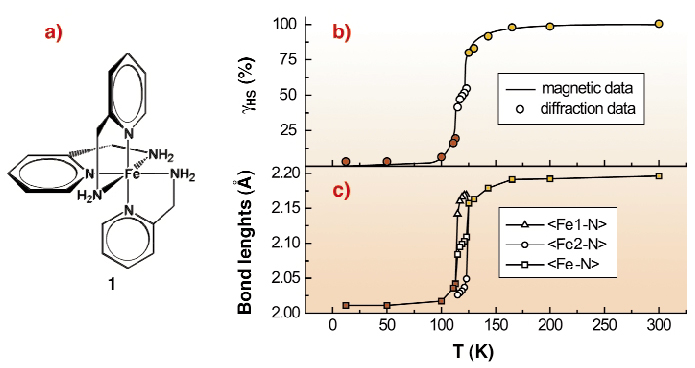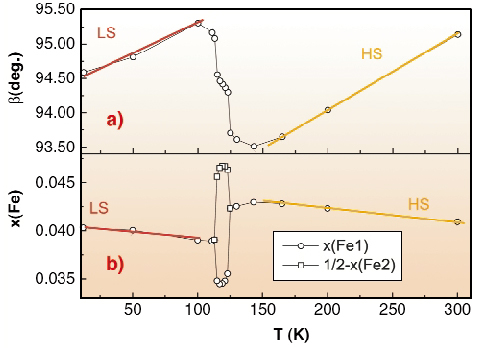- Home
- Users & Science
- Scientific Documentation
- ESRF Highlights
- ESRF Highlights 2003
- Materials Science
- Insights into a Spin Transition: Three Stable States of a Spin- crossover Crystal Built from Bi-stable Molecules
Insights into a Spin Transition: Three Stable States of a Spin- crossover Crystal Built from Bi-stable Molecules
The spin state of certain octahedral d6 iron(II) complexes may be switched between a low spin (LS) and a high spin (HS) state of nearly equal energies (LS, S = 0, t2g6eg0; HS, S = 2, t2g4eg2). The collective behaviour of such bi-stable molecules packed into a crystal lattice may lead to multi-stability in the solid state with a complex temperature and pressure dependence. Such phenomena are not only of basic scientific interest, they also hold the potential for technological applications [1, 2].
The compound [Fe||(2-pic)3]Cl2·EtOH (pic = picolylamine), 1, studied extensively for more than 20 years, shows stable HS and LS phases bracketing an intermediate phase (IP) with approximately equal concentrations of HS and LS molecules. (Figure 49) Inconclusive and contradictory characterisations of the nature of the IP have been given: a superstructure built from LS and HS molecules [3] as well as a glass-like state with short-range correlations between molecules in different spin states [1], both based on theoretical deliberations. Most interpretations of the experimental information favour a glass-like state with short-range correlations between HS and LS molecules [1].
 |
|
Fig. 49: (a) Iron(II) tris-2-picolylamine complex [Fe||(2-pic)3]2+. (b) Comparison of spin transition behaviour from diffraction and magnetisation experiments. The HS fraction |
We have investigated small crystals of 1 by X-ray diffraction at 16 temperatures between 12 and 298 K making use of the intense monochromatic X-ray flux and large-area image-plate detector at SNBL, beamline BM01A. The diffuse scattering expected from a glass-like state was not seen. Instead additional Bragg reflections, observed between T1 ~124(1) K and T2 ~114(1) K, revealed two successive phase transitions of the order-disorder type, thus indicating long-range correlations between LS and HS molecules and corroborating a superstructure in the IP. At temperatures above T1 a single iron site is occupied predominantly but not entirely with HS iron. Below T2 the single site is occupied predominantly with LS iron. The superstructure between T1 and T2 shows a doubling of the unit cell volume and two coexisting, but different, iron sites, one predominantly HS, the other predominantly LS.
At first glance the structure of the yellow HS phase and that of the red LS phase appear to be the same. On closer inspection it becomes evident that the unit-cell parameters and the atomic coordinates change discontinuously between the two phases (Figure 50). In the absence of an intermediate phase, the discontinuous changes in structural parameters would indicate a so-called isostructural phase transition, which is always of first order, analogous to a liquid-vapour transition. The actual sequence of the three phases is 're-entrant' in the sense that the symmetry of the HS structure reappears in the LS structure and vice versa. Such an isostructural/re-entrant sequence is relatively rare, and its detailed characterisation was only possible with an experimental protocol allowing for many crystal structures to be measured over as large a range of temperatures as possible. We are currently investigating relatives of 1, in which the ethanol molecule is replaced by methanol, 1-propanol, 2-propanol, allyl alcohol or t-butanol. Although these compounds have structures similar to that of 1, at least at 200 K, their spin-crossover behaviour is quite different, thus again calling for individually designed temperature dependent diffraction experiments.
 |
|
Fig. 50: Temperature dependence (a) of the monoclinic angle ß and (b) of the x-coordinates of the Fe-atoms. The coordinate of the second Fe atom in the intermediate phase is given as 1/2 - x(Fe2) for easier comparison with the first Fe atom. The yellow and red lines highlight the temperature dependence of ß and x(Fe) in the HS and LS structures. Standard uncertainties are approximately equal to symbol sizes. |
The results presented here, probably the most detailed and accurate structural description of a spin crossover coupled to an order-disorder phase transitions hitherto published, serve as a basis for developing and testing new models of these processes and their couplings. A Landau-type analysis of the diffraction data based on the symmetry changes observed in 1 leads to a generic phase diagram - to be given elsewhere - which appears to apply to related spin-crossover compounds as well. The combination of multiple-temperature diffraction data with a phenomenological theoretical analysis thus provides a unified description of different spin crossover scenarios occurring in chemically different compounds.
References
[1] P. Gütlich, Y. Garcia, H. Spiering, in Magnetism: Molecules to Materials IV, J.S. Miller, M. Drillon, eds, Wiley-VCH, 271-344 (2002).
[2] O. Kahn, C. Jay-Martinez, Science, 279, 44-48 (1998).
[3] A. Bousseksou, J. Nasser, J. Linares, K. Boukheddaden, F. Varret, J. Phys. I, 2, 1381-1403 (1992).
Principal Publication and Authors
D. Chernyshov (a, c), M. Hostettler (a), K.W. Törnroos (b), and H.-B. Bürgi (a), Angew. Chem. Int. Ed. 42, 3825-3830 (2003).
(a) Universität Bern (Switzerland)
(b) University of Bergen (Norway)
(c) Petersburg Nuclear Physics Institute, Gatchina (Russia)



